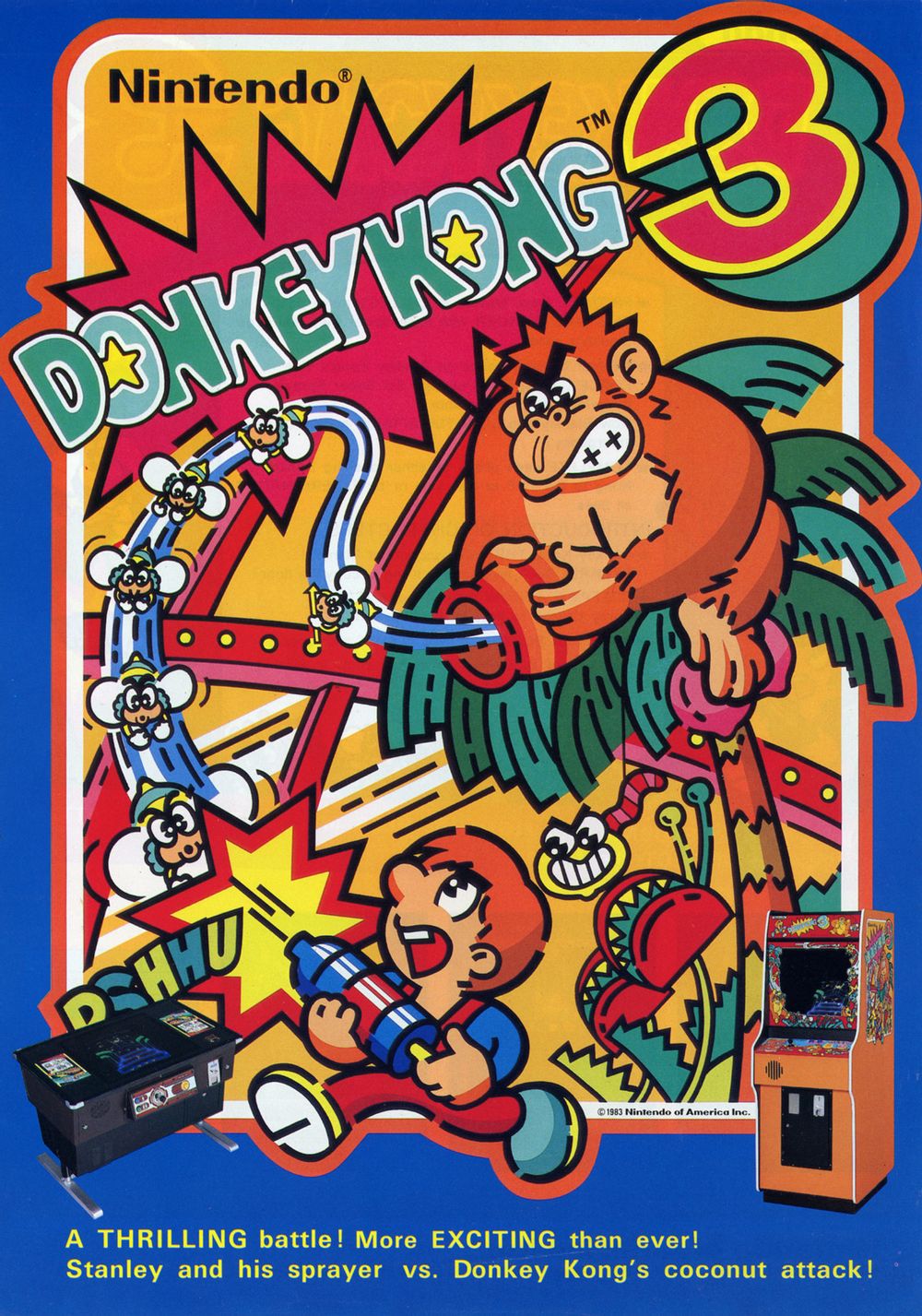
Donkey Kong 3 is the sequel to Donkey Kong Junior, and the third game in the original Donkey Kong trilogy. It was released for arcade machines in 1983, with it being ported to the Nintendo Entertainment System in 1986. Additionally, the NES version was later ported to the Nintendo Wii Virtual Console and the Nintendo Switch Online service, with the arcade version later being ported to the Switch as well as part of the Arcade Archives series by Hamster. There also exists an obsure sequel of sorts, developed by Hudson Soft (known for the early Mario Party games) titled Donkey Kong 3: The Great Counterattack. DK3's Shoot 'Em Up gameplay and absence of Mario tend to stick out as a sore thumb compared to other games in the series, and thus, the game rarely gets referenced in later Donkey Kong or Super Mario Bros. media. Nonetheless, the game does have its fans. Stanley the Bugman would go on to appear in the Saturday Supercade episode 'Greenhouse Gorilla', and as a spirit in Super Smash Bros. Ultimate.
The Excuse Plot is as follows: Donkey Kong breaks into Stanley the Bugman's greenhouse after being freed from capture in Donkey Kong Junior. DK then commands herds of bugs to steal Stanley's flowers, prompting Stanley to grab his bug spray, and shoot DK until he goes offscreen. Gameplay-wise, the game is a Shoot 'Em Up. DK is constantly climbing downward from the two poles he's holding onto, and he goes slightly upwards when you shoot him. You win levels by shooting DK until he's sent offscreen. There are multiple ways you can die: First of all, bugs are constantly flying towards your flowers, which are located at the bottom of the screen. If a bug comes in contact with one of the flowers, it steals it and starts flying upwards. If you shoot the bug in time, your flower is kept, but if the bug reaches the top of the screen, it is stolen. If all your flowers are stolen, you die. Second of all, If you get hit once by one of the bugs, you also die. And finally, if DK climbs all the way down from his poles, he jumps down and you die.
Donkey Kong 3 contains examples of:
- Adaptation Distillation: The NES version removes several of the game's cutscenes, such as the cutscene of Stanley being eaten by bugs in the Game Over sequence, and the final cutscene where Donkey Kong falls to the ground upon getting his head smashed into a beehive, followed by Stanley celebrating with a victory dance.
- Amazing Technicolor Population: Stanley is depicted with yellow skin in some promotional artwork, which is weird, as he doesn't have yellow skin in any version of the game.
- Bee Afraid: Buzzbees are bees that throw spears and steal your flowers. Beespies are stronger variations of them, which throw four spears upon dying.
- Big Bad: Donkey Kong returns as the main antagonist after being a Distressed Dude in Donkey Kong Junior.
- Bowdlerise: In the arcade version, Stanley gets eaten by the bugs upon dying. In the NES version, he just dies.
- Composite Character: Various elements of Stanley's design would later be incorporated into Mario in later games, mainly the physique and round nose.
- Cruel and Unusual Death: Upon dying, Stanley prompty gets Eaten Alive by bugs, leaving only his bug spray intact. Needless to say, this was cut from every single other version of the game for obvious reasons.
- Divergent Character Evolution: In this game, Stanley looks pretty much the same as Mario outside of his lack of a moustache. Later cameo appearances, such as his trophy appearance in the Super Smash Bros. series, change his color scheme from blue and red to blue and white in order to differentiate him from Mario.
- Early-Installment Weirdness: This game has the honor of being one of the few Mario games to not feature or mention Mario at all; instead, the protagonist is a bug exterminator called Stanley.
- Flat Character: Like many other NES protagonists, Stanley lacks any sort of personality. This can also be attributed to Stanley not appearing in any later ''Mario'' or ''Donkey Kong'' games so far.
- Genre Shift: The game is a Shoot 'Em Up, rather than a Platform Game like the previous two Donkey Kong games. Needless to say, this did not stick, and later Mario and Donkey Kong media would revert to platforming.
- Happy Dance: Stanley performs a victory dance upon beating DK. Though this was cut from the NES version.
- Invincible Minor Minion: Creepies are worms that can't be killed by any means, Though they don't attack, they temporarily stop moving when attacked, which can block your projectiles.
- The Many Deaths of You: You can die from being hit by bugs, having all your flowers stolen and Donkey Kong climbing too far down.
- One-Hit-Point Wonder: Like Mario and Donkey Kong Jr. in the previous games in the series, Stanley dies in a single hit.
- Perpetual Frowner: Stanley never smiles in promotional material, showing how serious he is about DK breaking into his greenhouse.
- Public Domain Soundtrack: The music that plays in the background of some of the levels is Flight of the Bumblebee by Nikolai Rimsky-Korsakov.
- Suspiciously Similar Substitute: Stanley is pretty much Mario without a mustache, right down to the color scheme.
- Transplant: An obscure fact about Stanley is that he actually originates from an old Game & Watch game titled Greenhouse.
- Tyop on the Cover: The NES version infamously stated that "Donkey Kong has plenty og cocnuts to hurl at you." on the back of the box art.
